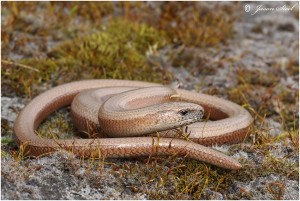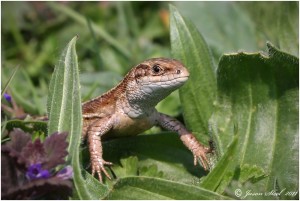Under pressure from sharply critical submissions by Bexley Natural Environment Forum and London Wildlife Trust, the Anderson Group, which is seeking permission from Bexley Council to build over 75% of the 22ha Erith Quarry, a Grade 1 Site of Importance for Nature Conservation, has released figures its own figures which show that the amount of habitat it proposes to leave is actually less than half that necessary for the actual number of reptiles caught so far.
Large numbers of animals have already been captured and ‘translocated’ to a concentration zone of only 1 hectare, which the company claimed would be adequate for hibernation. They will then be allowed out into an overall remnant area of 3.25 hectares that the ‘developer’ generously propose to leave in the long term.
In a letter originally sent to the Council on 20th January the company states that:
33. The numbers of reptiles translocated [in 2014] is detailed at section 7.103 of the ES. To reiterate, a total of 532 adult Slow Worm, 163 adult Common Lizard and 14 Grass Snakes were translocated. Population size estimates assumed the [current] availability of at least 8ha of suitable habitat.
- On the basis of the above availability of suitable habitat, this would give a Slow worm population of approximately 67 per hectare, a Common Lizard population of approximately 20 per hectare and a Grass Snake population of approximately 2 per hectare. These numbers correspond to a medium population of Slow-worms, mistakenly detailed as large in the Ecology Chapter, and small populations of Common Lizard and Grass Snake.
According to these figures the established carrying capacity of what the ‘developer’ itself regards as ‘suitable habitat’ is therefore 67, 20 and 2 per ha respectively (their own published data). On that basis the 3.25ha is only adequate for 218 Slow Worms, 65 Common Lizards and 6 Grass Snakes – in other words, it is less than half the area required to maintain something like existing numbers.

The Slow worm is a protected species, but ‘developer’ Andersons has already coralled more than 500 into a space they themselves have calculated should only support just over 200. (Photo: Jason Steel).
We also note with considerable concern that no mention is made in the capture figures of the juveniles born that summer, which should have added further to these totals and make the amount of space to be left for these animals even less adequate. It is also possible that by shovelling them into one smaller area that they will become more vulnerable to predators.
All UK reptiles are Biodiversity Action Plan species, so we should be seeking to protect and build populations. Andersons fails to address the conservation status of reptiles in London and Bexley in its documentation, preferring to hide behind the statement that these animals are still widespread. But so are a lot of other seriously declining species. Although Bexley is one of the best Boroughs in the capital for reptiles, and one of the 3 best for once much more common Common Lizards, only 3 of the modest 15 populations of this species in Bexley (13 if two of these are counted as meta-populations on conjoined sites) can be considered to occur in reasonably large, secure and hospitable areas with connections to a wider landscape of suitable habitat.

Bexley is one of the best Boroughs in London for declining Common Lizards, but has already authorised the removal of two populations to another site in the last 6 years, with the second one contrary to best practice guidelines and looking like it has failed. Only a handful of populations are on large, fairly secure sites connected to other suitable habitat. Will the Council now take pride in being a haven for reptiles or complacently sanction damage to Erith Quarry’s significant population on a large site? (Photo: Jason Steel)
What Andersons seeks to characterise as medium and small populations are considered by BNEF and LWT to be perhaps the best in Bexley and possibly some of the best in London, though inadequate data is available to verify this.
Andersons also makes the counter-rational and unsubstantiated claim that its proposals will enhance the overall biodiversity of Erith Quarry and have no impact on the amount of wildlife on nearby SINCs.
Bexley’s Local Development Framework (Feb 2012) has policy Policy CS17 d) protecting and enhancing the biodiversity, heritage and archaeological values of open spaces, including the Rivers Thames, Cray, Shuttle and their tributaries within the borough;
We do not believe that except in the short term, biodiversity (including populations = bio-abundance) can be maintained/protected or improved/enhanced by continuously eroding the amount of available (semi-)natural habitat.
The National Planning Policy Framework is clear that pursuing sustainable development includes moving from a net loss of biodiversity to achieving net gains for nature, and that a core principle for planning is that it should contribute to conserving and enhancing the natural environment and reducing pollution. (http://planningguidance.planningportal.gov.uk/blog/guidance/natural-environment/biodiversity-ecosystems-and-green-infrastructure/)
DEFRA has stated, in its guidance on the biodiversity duties of Local Authorities, that http://archive.defra.gov.uk/environment/biodiversity/documents/la-guid-english.pdf
5). Conserving biodiversity includes restoring and enhancing species populations and habitats, as well as protecting them.
It is our contention that Anderson’s application does the opposite. Moreover no credible plan is put forward to ‘mitigate’ the damage, which LWT has summarised as the loss of 13.5 ha of moderate or higher biodiversity value habitat. BNEF and LWT therefore continue to object to the proposal as a whole.
BNEF’s full submission in response to Anderson’s comments on our initial objection can be downloaded by clicking on this link:
https://app.box.com/shared/static/f76zdqxiq9ky8rlgjr6m1s5uyckti1w0.doc
The planning committee meeting for this application may now be on 31st March.
